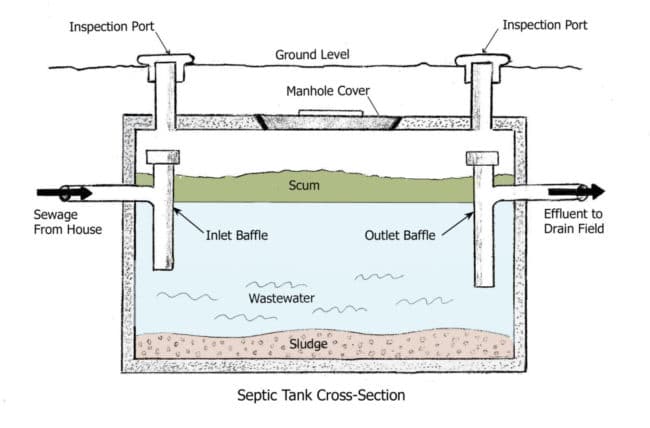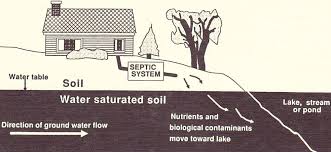When you flush your toilet, the contents don’t just disappear! If you’re like many watershed residents, what you flush down the toilet – and drain from your sinks and washing machines – ends up in a septic system.
Septic systems are commonly used in rural areas without centralized sewer systems, including the majority of the upper Raritan River watershed. Septic systems use a combination of nature and technology to treat wastewater from bathrooms, kitchens and laundry. A typical septic system consists of a septic tank and a drainage field.
Septic tanks work by allowing waste to separate into three layers: solids, liquid (effluent) and scum from oil and grease. Solids settle to the bottom of the tank, where microorganisms decompose them. The middle layer of effluent exits the tank and travels through underground perforated pipes into the drainage field. The scum floats on top.
One of the most important things homeowners can do to protect local water resources is have their septic systems pumped regularly. Excess nitrates and bacteria from poorly-maintained septics can contaminate nearby drinking water wells and streams.
In fact, malfunctioning septic systems are one of the most common causes of contaminated water found by Raritan Headwaters Association.
Fecal bacteria, such as Escherichia coli and enterococci, are shed by nearly all warm-blooded animals, including humans. The presence of these bacteria is one of the indicators used to assess water quality in rivers and streams. Did you know that high fecal bacteria levels have been found in streams throughout New Jersey?
Raritan Headwaters conducts annual bacteria monitoring of impaired streams throughout the upper Raritan River watershed. Last year, none of the 25 sites in the monitoring program met recreational standards. All had bacteria levels considered unsafe to swim in. We must do better!
 Bacteria and algal growth in waterways are a result of excess fertilizer, animal waste, and untreated wastewater. One of the biggest contributors to excessive nutrient and bacteria loads in our rivers is failing septic systems.
Bacteria and algal growth in waterways are a result of excess fertilizer, animal waste, and untreated wastewater. One of the biggest contributors to excessive nutrient and bacteria loads in our rivers is failing septic systems.
So how can you avoid being part of the problem and start being part of the solution? Maintain your septic and use water efficiently!
Have your septic system pumped and inspected every three years. Pumping removes excess solids and scum from septic tanks and allows them to work at maximum efficiency. Waste is taken to a wastewater facility, where it can be safely treated and discharged back into the environment.
Don’t forget: Groundwater provides 40 percent of the state’s potable water supply, and possibly 100 percent of your own supply if your neighborhood relies on private wells.
Here are some other ways you can prevent excess bacteria from overloading surface and ground water:
Avoid pouring harsh products down the drain. Oils, grease, chemicals, paint, and medications should not be poured into the sink or toilet. Non-degradable products like dental floss, disposable wipes, and cat litter should be thrown away in the trash instead of flushed. Not only are these products not good for the environment, they aren’t good for your septic system either and may lead to costly repairs and/or cost more to pump out.
Use water efficiently. Fixing a leaky faucet or running toilet can save as much as 200 gallons of water per day. Installing EnergyStar and WaterSense labeled products like high-efficiency toilets and washing machines can drastically reduce the amount of water your household consumes.
Proper disposal of unused or expired medications. Pharmaceuticals are ending up in waterways, including drinking water sources. Stop unused drugs from getting into the environment by utilizing your local Rx Drop Box.
Maintaining your septic goes hand in hand with caring for your drinking water supply, especially if you have a private well. Excess nitrates and bacteria from an unmaintained septic system may contaminate nearby drinking water wells. It is important to test your well for these contaminants every year to ensure that it has not been polluted by nearby septic systems.
Learn more about maintaining your on-site wastewater treatment system with the Homeowner’s Guide to Septic Systems or by visiting the EPA’s Septic Smart website.
